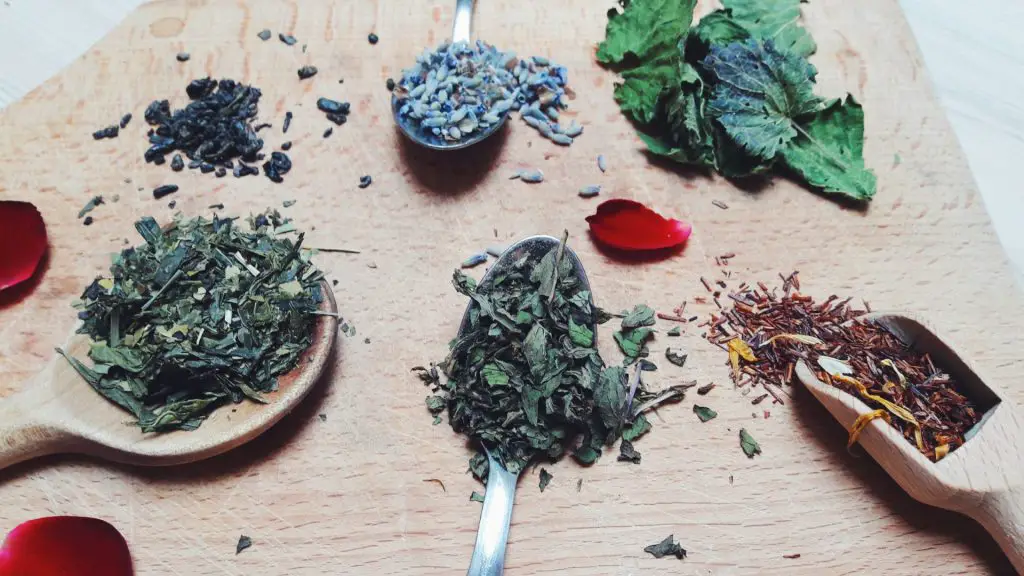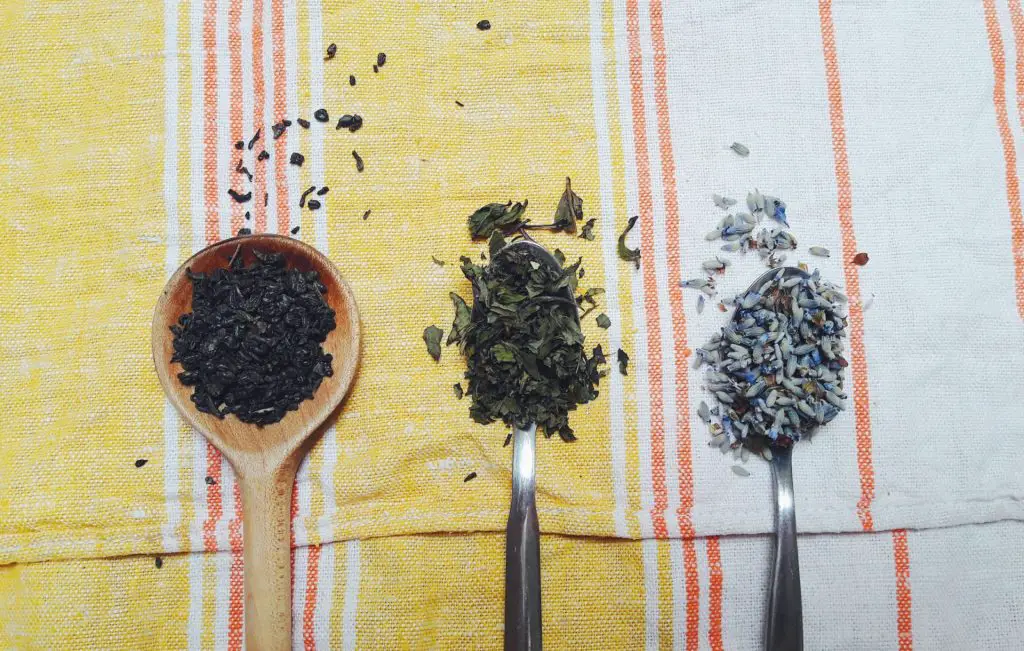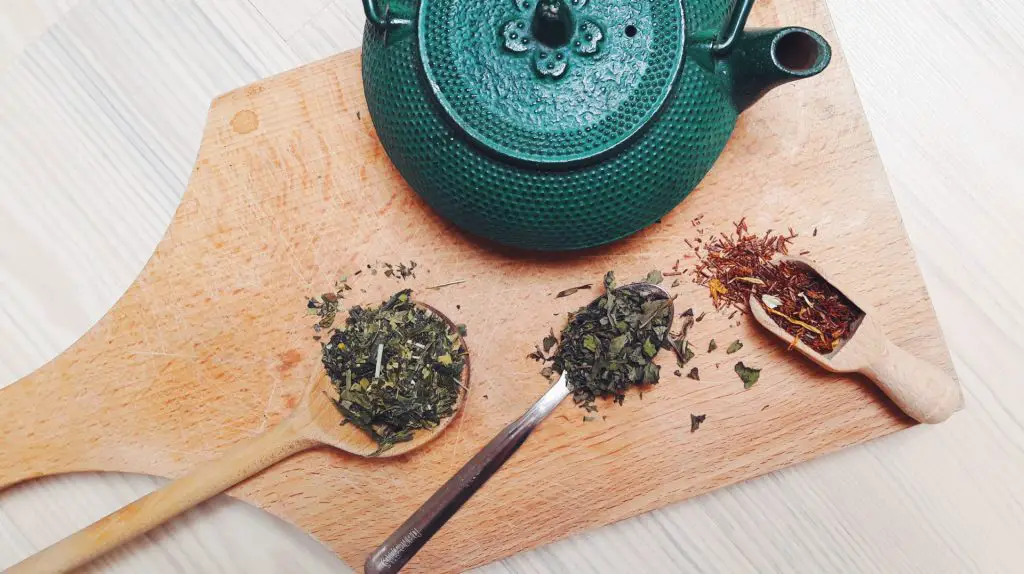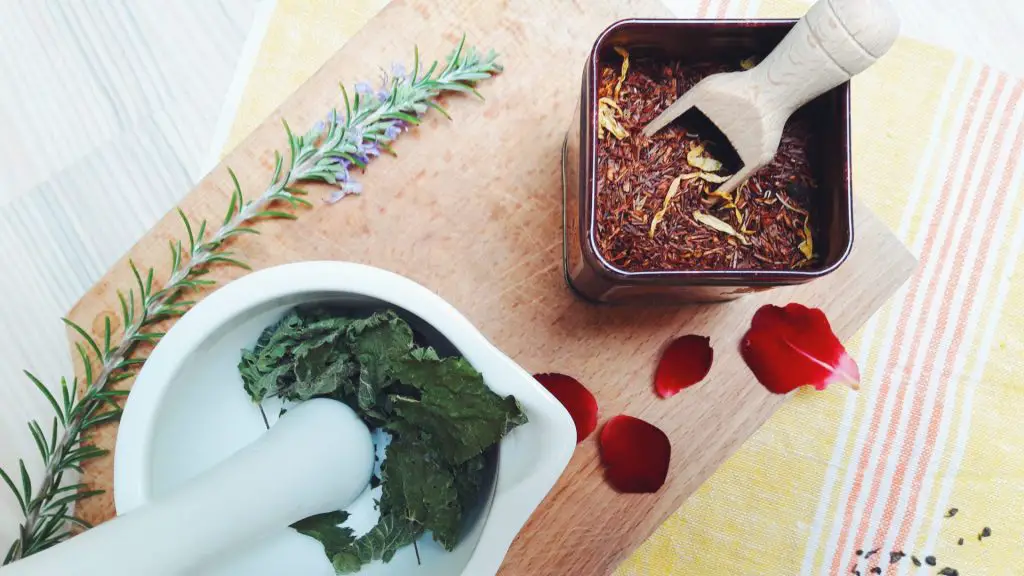Hey, guys! Do you want to know how to make your own herbal tea blend? Have a look at this guide, because there is nothing better than having a nice fragrant cup of homemade herbal tea blend, right?
Yes, I’ve gotten into my autumn mood already, and have just checked all the herbs that I’ve stored and dried during the summer. Even though my favorite is still green tea, I am a sucker for anything tasty and tea-like.
Let’s have a look at homemade herbal tea blends! These soothe stress levels and help you calm your nerves!
Herbal tea love story
Ever since I was a little girl, I would help my grandma pick herbs she had planted around the house, or those that were wild: chamomile, stinging nettles, calendula, mint, roses, (she grew the most beautiful fragrant velvet roses), birch, linden, and others. She’d always dry these leaves, flowers, and herbs and then store them for the long cold winter to aid and treat our coughs, headaches, tiredness, or anxiety.

5 reasons why you should make herbal tea yourself
- Because you can experiment as much as you’d like
- You can only use the ingredients you like
- Because it’s completely natural- you know what’s in your cup of tea
- Because it’s tasty and healthy
- It’s cheap
You can even blend herbs with already existing teas, such as green, white, or black tea. I found this tasty recipe (a very simple one) on Rosy Black Tea (from Nourishing Simplicity). Just so that you have an idea of how easy it can be.
Have a look at the following paragraph on the top herbs you should keep at home and blend them to your liking. Below, I’ve also made a short list of possible additions to your freshly homemade herbal tea.
10 herbs you should keep in your pantry

Lemon balm (Melissa officinalis)
Lemon balm is a part of the mint family. Fresh or dried leaves of lemon balm improve any beverage, alcoholic, tea or a mocktail.
Lemon balm has a soft yet refreshing taste, that comes with a lot of benefits: lemon balm has antiviral properties. It can be useful when treating cold sores, improves digestion, boosts immunity.
It is very beneficial for the skin as well, can aid with muscle pains, tense nerves, insomnia, and even migraine.
It’s a must in tea blends for anxiety since it’s soothing and it elevates mood. Apart from that it also provides you with the necessary antioxidant boost.
Mint (Mentha)
Similar to lemon balm, fresh or dried mint leaves are a great addition to cold or warm beverages.
It’s a must in a mojito, yes, but have a look at health benefits this fragrant plant has to offer: mint aids with digestion, headache, and respiratory disorders. It offers relief to the nose, throat and lung problems. It aids with the common cold, and it has antiseptic properties. Mint improves oral health, relaxes the nerves and naturally boosts your mood.
Chamomile (Matricaria Chamomilla)
Chamomile is a plant that offers numerous positive benefits for our health; chamomile is both anti-inflammatory and antispastic. It aids with stomach problems, diarrhea, and intestine problems. Chamomile soothes tense nerves in case of anxiety (yes, another great ingredient in tea blends for anxiety) and mental tiredness, it keeps teeth and gums healthy.
Chamomile aids with eczema and it has a detoxifying effect on internal organs. A few other benefits that chamomile has to offer are that it aids with healing wounds, boosts skin rejuvenation, it has anti-inflammatory properties. Read more about other chamomile health, skin and hair benefits here.
Linden (Tilia Platyphyllos)
You can prepare the tea from dried linden leaves and flowers. It has a relaxing effect; it is a perfect natural remedy for a stressful day. It soothes the nerves, providing the calming effect.
Linden flower tea aids digestion, detoxifies your body and stimulates the liver. Linden flower tea helps with urinary infections, it also keeps the heart healthy, offers support and relief with first signs of the common cold as well as the fever.
Dandelion (Taraxacum officinale)
Dandelion tea can be made with dried dandelion flowers as well as leaves. Dandelion is very beneficial for our health; it is rich in calcium, aids with liver disorders, and even acne and eczema.
In case you have problems with constipation, turn to dandelion, since it contains a high level of dietary fiber, which aids digestion and reduces the chance of diarrhea.
Dandelion provides you with a high dose of antioxidants, it regulates blood pressure and it is high in vitamin C.
Elderflower (Sambucus)
Elderflower has a long history as a natural remedy; it has antiseptic and anti-inflammatory properties. Elderflowers is used to treat flu, common cold and sinus infections.
It also helps with digestion and boosts our immune system.
Remember that only flowers and berries are safe to consume, but the elderberries are toxic when raw, therefore should be cooked before using.
Stinging nettle (Urtica Dioica)
Stinging nettle has a great ability to detoxify our bodies. It improves metabolism, boosts immune health and improves circulation.
With its anti-inflammatory properties is definitely a must-keep in everyone’s pantry. Stinging nettle is loaded with vitamin C and iron.
It is often used to treat respiratory problems, improves heart health and it can aid with acne. Stinging nettle contains a lot of antioxidants which take care of our skin health, aid with anti-aging and reduce wrinkles as well as dark spots.
Read more on stinging nettle benefits and how to forage them here. If you want, you can make a healthy and delicious stinging nettle and wild garlic soup, get the recipe here.
Rosehip (Rosa Canina)
Dry the red berries and use them to make a tea. Rosehip is very beneficial for our bodies as well as our skin: it regulates and lowers cholesterol levels.
Rosehip improves our heart health, it has anti-inflammatory properties, it is high in vitamin C, which is why rosehip also keeps blood vessels healthy.
It regulates blood pressure and it has a positive effect on our skin health (rosehip oil is very beneficial for various skin problems and acne scars!).
Sage (Salvia Officinalis)
Sage herbal tea is prepared with dried sage leaves. It has anti-inflammatory, antiseptic and antibacterial properties, so it’s beneficial in a case of any gum, mouth or throat infections.
Sage soothes the aching throat, lowers the cholesterol levels and it may reduce the chances of diabetes. It is beneficial for the cardiovascular system, it reduces the tension in the muscles and since it has a relaxing effect, it can be used in case of tense nerves. Sage is useful for women in menopause because it aids with menopausal sweats.
Raspberry leaf (Rubus idaeus)
Raspberry leaf tea is highly beneficial, especially for women. Raspberry leaf has antispasmodic properties and it is especially recommended for women.
Apart from this, it should prevent gum bleeding, and with diarrhea and other digestion problems.
Raspberry leaf has anti-inflammatory properties. Supposedly it should help regulate strong and irregular period cycles, as well as menstrual cramps. It is a rich source of iron, manganese, magnesium and vitamins B1, B3 and E.
I’d advise you to try and drink each herb separately for a while so that you get to know the flavor and decide if that might be something you’d like to continue using. After you get to know your preferences and you cross out some of the herbs you’re not really into, you can start experimenting.
How to make homemade tea blends in 3 steps

Even though there are some rules when it comes to making DIY herbal tea blends, you can add pretty much anything to your tea base, once you are familiar with the tastes and your preferences.
If you are the kind of person who loves drinking tea and experimenting on a cold rainy day, here is a simple 3-step procedure that may help you decide what you actually want in your blend.
Remember that you probably need to try each ingredient separately, so that you actually know what you’re blending. Test the ingredients and the first two steps separately. That way you can be sure you’ve chosen the best herbal tea blends for your taste.
1. Decide on your base
This means there is that one ingredient that you base your tea on. It’s the one ingredient you can feel in your tea right away when you take a sip of it.
Here is a list of ideas you can your as your primary ingredient:
- Black tea: English breakfast, early grey…
- Green tea: gunpowder, matcha…
- Red rooibos tea
- Yerba mate
- Herbal tea: peppermint, chamomile, raspberry leaf, elderflower, sage, linden…
Again, make sure that you already know what you’re using as a base. Try and taste all the different herbs and flavors you want to add to the mixture, otherwise, you might end up with a blend you don’t like.
2. Add another flavor (or four)
Once you have your base, add another flavor to it. Some say that you can add up as much as 5 flavors, but I like to keep it simple. My preference is always a base, one another flavor and some extra touches, such as cinnamon, cloves, lavender… But feel free to fill up that jar you’re storing your tea into:
- Chamomile, lavender, Echinacea
- Rose petals, hibiscus, rosehip, calendula
- Cinnamon, vanilla bean, anise
- Basil, marjoram, rosemary, thyme
3. Decide on dried fruits, flowers, and spices
Once you have your mixture blended and you like it, that’s when you can add the finishing touches to it and make it your personal herbal tea blend. Add an extra flavor for that special kick to the blend:
- Dried raspberries, blueberries, strawberries
- Dried goji berries, juniper berries, cranberries
- Dried rosehip, dried pomegranate seeds
- Fennel seeds, cloves, cardamom, nutmeg
- Lemon, orange or grapefruit peel
- Dried jasmine flowers, dried hibiscus flower, or even dried coconut flakes
Where do I keep my herbal tea blends?
Always store your herbal tea blends in a dry and dark space. Make sure that they are stored in an air-tight container. This way the herbs will keep their fragrance longer, and there won’t be any humidity and mole that could have access to them.
My top 5 favorite homemade herbal tea blends for stress

When I prepare my own blends I usually go for the same quantity of each ingredient. The only difference I make is with ginger as my base; I usually cut fresh pieces from a ginger root (about 1 tablespoon), because I like my ginger tea strong and burning. Also, apart from ginger (which I always use fresh), every other herbal blend is made with dried ingredients. This way I can store the blends longer and I don’t have to worry about anything getting to them.
Anti-inflammatory ginger tea
- Ginger (1 tbsp)
- Cinnamon (1/2 tsp)
- Turmeric (1 tsp)
- Half of freshly squeezed lemon
Every time I feel a cough, a cold or a runny nose coming up, I always make this tea. I love ginger so making a strong brew is all I think about. Some say that this is also a drink to detoxify your liver. I add the lemon juice when the brew has already cooled down a bit; adding lemon to hot steaming water may cause it to lose its nutrients.
Soothing sweet tea blend
- Mint (1 tsp)
- Dried rosehip (1 tsp)
- Hibiscus flower (1 tsp)
If you want your tea fresh (minty) but prefer a bit of a sweeter tone to it, less herbal, more flower-like, then this one is for you. Mint will help you relax and calm down, while both rosehip and hibiscus have the sweet yet tart flavor that keeps a nice balance on my taste buds.
Morning kick of freshness blend
- Green tea (1 tsp)
- Lemongrass (1 tsp)
- Stinging nettle (1 tsp)
Lemongrass to boost my mood and wake me up in the morning or whenever I need to focus. Stinging nettles? Because they provide me with a ton of benefits (read more on that here). I usually don’t drink on them their own (don’t know why, really) but with green tea, I think it’s the perfect combo.
Calming stress relief tea recipe
- Lavender (1 tsp)
- Chamomile (1 tsp)
- Lemon balm (1 tsp)
Both lavender and chamomile have a soothing and relaxing effect on us. Both can be used if you’re having trouble falling asleep if you need to relax and unwind after a long and stressful day. Lemon balm just adds the extra kick into the blend, while also used to relax and aid with insomnia, it is a nice fresh change.
Autumn tea blend
- Stinging nettle (1 tsp)
- Rosehip (1 tsp)
- Lemon balm (1 tsp)
- Peppermint (1 tsp)
- Cinnamon stick (half)
Sometimes I’d add a piece or two of ginger to this blend, but that depends on whether I have some at home or not.
What’s your herbal tea blend? Let me know in the comments below!
Stay Wild!
Help support Wild for Nature
Many of you have asked if there’s a way to help support Wild for Nature. I’ve signed up for Buy Me Coffee. If you love what I do, learn from me, sell anything you made from my recipes, and want to see Wild for Nature grow even more, I’d be thrilled if you’d consider buying me a coffee! It works as a one-time or a monthly donation of $3. You can also get beautifully designed PDFs with a series of recipes and other resources I publish there, to help you learn and get creative at home! I can then use that money to further develop and grow Wild for Nature and you can help me continue with wild creations and resources!

I LOVE this article! Are your tea recipes still available? I clicked to Buy You a Coffee but I couldn’t find the recipes 😕
Hey Robyn, thank you for your lovely comment :). You can find the recipes at the bottom of the article, right here!
How much of these do you use and how much water? Just fill the cup?
Hey Nicole, yes, just fill the cup with water, the recipes are meant per cup. Hope this helps!